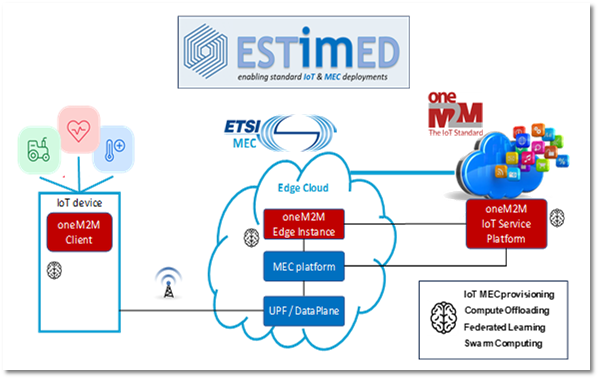November 2025 - For this interview, we hear from Joachim Koss (JK) about the ESTIMED project. ESTIMED stands for “Enabling Standardized IoT deployments in MEC Environments.” A key project goal is to bridge the gap between IoT platforms and edge computing. Joachim is the founder and principal consultant of JK Consulting and Projects, a consulting firm that supports companies in the area of Machine-to-Machine (M2M), Internet of Things (IoT) technologies, product type approvals, and project management for Quality Management Systems (QMS).
Q: Would you begin with some introductory information about yourself and your business?
 JK: I look back to more than 41 years of professional experience from telecommunications business units in several companies, including Siemens, Gemalto and others, where I held various management positions.
JK: I look back to more than 41 years of professional experience from telecommunications business units in several companies, including Siemens, Gemalto and others, where I held various management positions.
Since 2006 I have been working in standardization. I participate in several international standards development organizations (SDOs) such as ETSI, oneM2M, and the ITU. I have also contributed to the national SDO DKE (German Commission for Electrical, Electronic & Information Technologies), to European Commission initiatives, and industry alliances such as the Open Mobile Alliance (OMA), Global System for Mobile Communications Association (GSMA), Digital SME, and the German Association for the Automotive Industry (VDA).
Over the years, I became convinced about the importance of M2M communications, the IoT, and interoperability. As a result, I got involved in the foundation of the ETSI SmartM2M Technical Committee and the ETSI oneM2M partnership project. I held the role of Vice Chair of SmartM2M for four years and was a Vice Chair of oneM2M’s Technical Plenary for two years. I also led several ETSI Specialist Task Forces on IoT standards, contributing to several ETSI Technical Reports and Specifications.
Among my current activities, I am an expert of Small Business Standards (SBS) for IEC/ISO standardization. I contribute to oneM2M with a focus on architectural evolutions. I am also the project lead for the ESTIMED project.
Q: Would you describe the ESTIMED project for our readers?
JK: ESTIMED is a project focused on enabling standardized IoT deployments in MEC environments for advanced systems. From an organizational standpoint, the project is being is conducted as an ETSI Specialist Task Force, STF 685 to be precise. It focuses on enabling standardized IoT deployments within Multi-access Edge Computing (MEC) environments.
As part of the broader ETSI and oneM2M ecosystem, ESTIMED addresses the need for interoperable, efficient, and scalable solutions that support advanced IoT-based systems. This initiative contributes to bridging the gap between IoT platforms and edge computing architectures. The emphasis is on delivering practical guidelines, architectural evolutions, and testing assets.

The project is supported by EC/EFTA funding. It aligns with European priorities for digital transformation across sectors such as smart mobility, industrial automation, and public safety.
Q: Would you outline the approach you are taking with the project?
JK: The team’s approach involves a comprehensive examination of existing oneM2M and MEC implementations, including their architectures, APIs, and functional components. There is a separate activity that focuses on defining a set of representative Edge-IoT use cases. The approach brings these two strands together by investigating how the technical elements can be aligned and integrated to address the operational requirements of the use cases. This sets the foundations to explore the technical feasibility and practical benefits of interworking between the two frameworks.
Such integration is not approached as a purely theoretical exercise. Our approach is rooted in real-world application contexts, ensuring that the proposed solutions remain grounded, scalable, and actionable.
The project started in January 2025 with a duration of three years. It involves ten contributing organizations/companies with more than twenty-five experts. We envisage developing thirty documents and running three Hackathons over the course of the project as part of our approach to encourage adoption and develop industry and user ecosystems. In fact, the first hackathon took place towards the end of October with the following objectives:
- Identify and define innovative use cases that address IoT and Edge Computing problems and challenges.
- Provide high level architecture solutions, explaining how the combination of oneM2M and MEC addresses identified challenges.
- An optional, third objective invites participants to develop a prototype MEC or oneM2M application exploiting existing oneM2M/MEC implementations, either in a form of a technical document or a real prototype.
There should be more information forthcoming once the team has processed the hackathon submissions.
Q: What makes Edge IoT an important topic?
JK: Internet-of-Things (IoT) and edge computing are key enablers for the digital economy, with high potential in the industrial sector where 5G networks offer low latency and bandwidth efficiency advantages. The interoperable design of edge IoT systems can allow clusters of devices and agents to interact with each other to achieve common goals, e.g. using swarm computing techniques. These deployments require unifying standards from the edge IoT space, in the form of ETSI ISG MEC for multi-access Edge computing, and oneM2M for interoperable IoT systems.
Q: Would you discuss the background to ETSI MEC and oneM2M cooperating?
JK: In June 2023, experts from MEC, oneM2M and SmartM2M described how the ETSI MEC and oneM2M architectures complement each other to enable full data access and interoperability. Here is the White Paper they published.
The findings included initial ideas on deployment options, the definition of specific use cases, and requirements that could demonstrate MEC-oneM2M integrations. These ideas, on paper, are the basis for defining proof-of-concept demonstrators.
The interworking between MEC and oneM2M standard architectures can enable IoT edge services. Examples include mobility in smart city settings and real-time analytics. These would build on a oneM2M common service layer instantiated on top of one or more MEC hosts. Interworking architectures would equip MEC applications to exploit IoT-generated data arriving through oneM2M standard platforms that are configured to support the MEC system architecture and related APIs.
The European Commission accepted an ETSI proposal for the “ESTIMED” project, based on the ETSI White Paper. The project was commissioned, with EC/EFTA funding, and ETSI appointed to execute it.
Q: ESTIMED is a multi-company project, so which organizations are involved?
JK: There are three categories of organization contributing MEC and oneM2M expertise to the project:
- The European DIGITAL SME Alliance is a community that represents over 45,000 small and medium ICT enterprises in thirty countries and regions in the EU and neighbouring countries (sending oneM2M specialists)
- Commercial organizations:
- Exacta Global Smart Solutions (sending oneM2M specialist and contributing knowledge about the oneM2M ACME CSE)
- FSCOM SARL (sending MEC specialists and contributing knowledge about the MEC Sandbox)
- JK Consulting and Projects (sending oneM2M specialists and contributing project management, and oneM2M ACME CSE expertise)
- Nextworks S.r.l (sending MEC specialists)
- Samir Medjiah (sending oneM2M specialists)
- xFlow Research Inc. (sending MEC specialists and contributing knowledge about the MEC Sandbox)
- Academia:
- CNIT - National Inter-University Consortium for Telecommunications (sending MEC specialists)
- Sejong University (sending oneM2M specialists and contributing knowledge about tinyIoT
- UniMore - Università di Modena e Reggio Emilia (sending MEC specialists)
Q: What are the EU's goals from this project?
JK: An important consideration among European goals is to assist Small and Medium Sized Enterprises (SMEs). This is reflected in the participation of Digital SME, for example, to represent the interests of more than 45,000 SMEs in the standardization process.
The focus on SMEs implies the need for technical solutions that can begin from a small scale and grow without user organizations having to lock-in to large cloud service providers. This is attainable through standardization which makes it easier for multiple organizations to work together and capitalize on interoperability benefits.
This project also responds to Topic 18 of the standardization action grants offered by the European Commission under SMP-STAND-2024-ESOS-01-IBA. Topic 18 focuses on “Enabling standardized interoperability and access to data in IoT Edge and swarm computing environments”. The call for proposals deals with support to standardization activities performed by CEN, CENELEC and ETSI. The call was published on 21 March 2024 and falls under the standardization strand of the Single Market Programme which is the EU funding programme to help the single market reach its full potential and ensure Europe’s recovery from the COVID-19 pandemic. With €4.2 billion over the period of 2021-2027, it provides an integrated package to support and strengthen the governance of the single market.
In addition, the project standardization work addresses the challenges raised by the Single Market Programme. This focuses on improving the IoT interoperability by fostering new edge-cloud paradigms and emerging concepts.
Q: Where can readers find more information about the project?
JK: The best places to start for more in-depth information are the homepages for ESTIMED and the public-facing ETSI STF 685 portal. I am also happy to respond to questions that your readers can send via email to This email address is being protected from spambots. You need JavaScript enabled to view it..
